San Diego State vs. Washington State: Ten Things to Watch

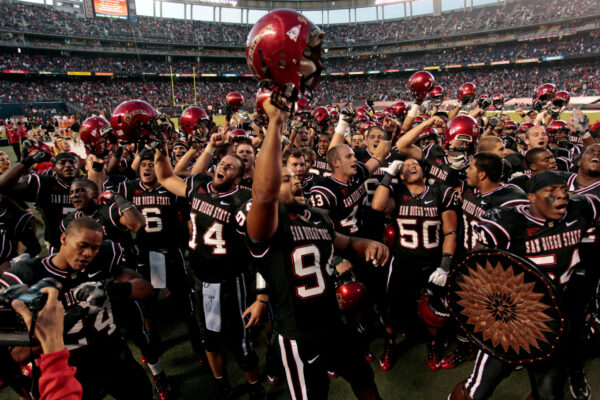
Washington State will always hold a special place in the hearts of SDSU fans.
Most recently, the Cougars and Oregon State ended SDSU’s decades-long pursuit of a Pac-12 invitation. While the Conference of Champions does not have most of its traditional schools, the Aztecs are in an enviable position in their new home.
Before the events that will link WSU and SDSU together for the foreseeable future, Washington State signified an important milestone for the Aztecs. The two programs last met on the gridiron on September 17, 2011. SDSU’s victory on that day showed the Aztecs’ emergence as a football school.
Defeating a Pac-12 opponent proved that 2010 was not a fluke. The Aztecs, even after losing its head coach to Michigan, would continue winning.
SDSU has done that. They boast the 20th-best winning percentage in the country since 2015. SDSU trails Ohio State by five ten thousandths of a point for the best-combined football and men’s basketball record since 2010.
In 2011, the Aztecs were favored by a touchdown. It was an amazing line, considering SDSU had not defeated a Pac-12 opponent since 1995, a span of 5,858 days. The win gave the Aztecs a 3-0 start for the first time since 1981.
Washington State enters Snapdragon Stadium this year as a heavy favorite. The Cougars are predicted to win by more than two touchdowns. Below are ten storylines that make the contest compelling, including some keys for SDSU to beat the odds on Saturday.

10. Reception for Trey White
Akron, Arizona, Arkansas St., BYU, Kent St., Middle Tenn., Oklahoma St., Rutgers, Southern Miss., Stanford, Utah St., Virginia, Wisconsin, Jacksonville St., Charlotte, FIU, Ga. Southern, Miami (OH), Ohio, Tulsa, UAB, Western Mich., Georgia St., Houston, New Mexico St., Temple, Troy, UCLA, Washington St., App State, Colorado St., Fla. Atlantic, Iowa St., Louisiana, South Alabama, New Mexico, Southern California, UCF, Wake Forest, Georgia Tech, Nevada, Wyoming, Massachusetts, Texas Tech, Air Force, Mississippi St., and Oregon St.
Trey White’s NCAA-leading 1.83 sacks per game exceeds the averages of the 47 FBS teams listed above.
White’s dominance earned him inclusion in numerous midseason All-American lists, including a first-team selection by the Associated Press. He was also added to the Chuck Bednarik Award midseason watch list. The award is given out annually to the best defensive player in college football.
Witnessing Aztec Nation’s reception of White is something to follow on Saturday. It will be SDSU’s second home game in 49 days. During this scheduling quirk, White’s reputation has grown exponentially. Locally, nearly every Aztec-related story includes him.
The last time White lined up at Snapdragon, his star was on the ascent. His dominance over Hawai’i down the stretch displayed to the home fans what away crowds have witnessed all season.
White only had half a sack over the season’s first two games. Both were played in Mission Valley. He has had 10.5 since, but only three came in San Diego.
Washington State is the first opportunity for America’s Finest City to anticipate the performance of its native son. From the greeting at the Warrior Walk to reserving the loudest cheers for when his name is called, all eyes will be on Trey White.
9. Making a Run at the Title
Before the team emerges from the locker room for warmups, the Aztecs, who have been injured this year, come out for extra stretching. The group has increased every week, and the bye week came at a perfect time for them.
In addition to improved health, the time off teases the possibility of the Aztecs improving their play. SDSU is 2-0 in the Mountain West, but aside from the standings, nothing suggests they will make a serious run at the title. Sneaking into a bowl appears to the ceiling for this team.
A competitive showing against Washington State would change expectations. SDSU will not benefit from the talent advantages it has had the past three contests, but it will not be at a serious disadvantage either. Execution has been lacking this season, not athleticism.
While the bye week won’t bring new players, the Aztecs should be better at running their coaches’ systems.
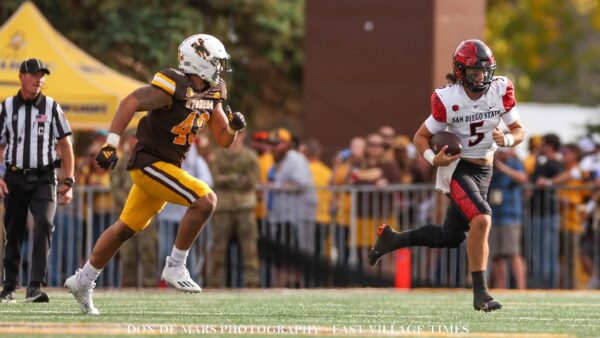
8. Controlling the C Gap
Among the players with a chance to heal was starting quarterback Danny O’Neil. The young signal caller’s knee injury has prevented him from filling a role that head coach Sean Lewis called “vital” this week.
The Aztecs are looking for a QB who can move around and make off-script plays and someone who can “control the C gap.” Lewis wants his QB to occupy the defender outside of the tackle on a read/option to give the offense superior numbers in the running game.
This season, O’Neil has rushed 18 times for 89 yards when sacks are subtracted from his total. His 3.6 attempts per game shows he is not proficient in this area yet. In contrast, Javance Tupou’atu-Johnson had six carries for 26 yards in his only start of the season. O’Neil has carried the ball six times in only one game (Central Michigan) this year.
O’Neil’s 18 rushing attempts project to about 45 for the year. That number would be significantly fewer than the best QBs who have played under Lewis in the past. At Kent State in 2022, Dustin Crum rushed for 967 gross yards (703 net) on about* 125 carries. Crum’s near eight yards per attempt shows how lethal a dual-threat QB can be in Lewis’ system.
Lewis insisted this week that explosiveness on the ground is a secondary consideration for the quarterbacks in his system. Since Crum was the last signal caller under Lewis as head coach, he is the easiest quarterback to compare to O’Neil, but he is not the fairest. Current QB coach Matt Johnson, under Lewis at Bowling Green, is a more equitable juxtaposition.
In 2015, Johnson rushed for 408 net yards on about* 80 carries. His per-carry average (5.1) was almost identical to O’Neil’s 4.9 rate this season. The difference was that Johnson carried the ball two or three times more per game.
Experience and health, not ability, might explain why O’Neil has not excelled at picking up small gains on the ground to prevent the offense from falling behind the chains. Whatever the cause, defensive ends are keying on Marquez Cooper in the read/option. Against Washington State, O’Neil needs to do just a little bit more to make them play honest.
The storylines to watch are whether he is healthy enough to run the ball and how his athleticism matches up against the Cougars.
* Statistics do not show exactly how many sacks Crum and Johnson took.
7. Offensive Line Play
O’Neil’s inability to control the C-gap has contributed to SDSU’s inefficiency in its rushing attack, but it is not the only culprit. The offensive line has also not held up well at the point of attack, especially on the interior.
Poor O-Line play has led to another subpar aspect of the offense’s play. With defenses keying on Cooper by stacking the box, O’Neil has less room to find receivers on quick throws in the intermediate passing game. The Aztecs haven’t been able to capitalize on having all the defenders inside because the offensive line has not allowed O’Neil to go through his progressions.
“Now what, so what” is a phrase Lewis uses to describe the resilient approach he wants his team to display. For all the injury issues on the offensive line, on Saturday, the group should be as whole as it’s been all year.
Joe Borjon went down for the season, and Christian Jones swung to left tackle six games ago. After Jones’ move, the team held various auditions to replace him at left guard before moving Ross Ulugalu-Maseuli there and starting Tyler McMahan at right guard. Washington State should be the fourth start with this combination.
During the team’s last bye week a month ago, center Brayden Bryant injured his leg. He should be at his healthiest since the injury occurred.
The offensive line has performed up to expectations when including the qualifications that it lost four 2023 starters to the transfer portal and the athletes brought in to replace them to injury. That nuance no longer holds weight.
Short of another injury, the line is out of excuses. The current group has been together for a third of a season. Chemistry should not be a problem. It is time for them to produce.
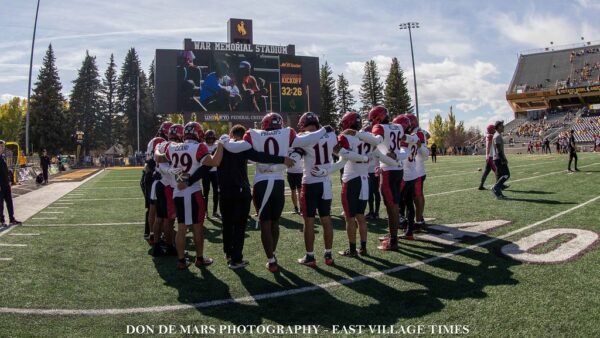
6. Stopping the Run
SDSU’s rush defense ranks 96th in the country, giving up 167.2 yards each game. The Aztecs are arguably worse than their numbers indicate.
Games against Hawai’i and Texas A&M-Commerce buoy their statistics. The Rainbow Warriors (83.9 yards per game) and Lions (85) are two of the worst running teams in Division I.
Their average balloons to 214 yards in the other four games. Only once have the Aztecs held their opponents significantly below their season mark. SDSU held Central Michigan to 154 yards, about 40 below their typical output. Cal and Wyoming are statistically among the worst rushing teams in the country but dominated SDSU on the ground.
Washington State is in the top 50 in the country in rushing offense. Averaging 176 yards, they will be a stern test for the Aztecs.
The Cougars ground game has been slowed in recent weeks. Three games ago, Boise State held WSU to a season-low 89 yards. The Broncos might have found a weakness because Fresno State and Hawai’i each held Washington State to 123 rushing yards.
5. Pressure on the EDGE
On paper, the weakness and strength of the 4-2-5 reside in the EDGE defenders. SDSU is second in the country with 25 sacks. The EDGEs have 17.5 of those. The EDGE room, apart from White, nearly matches the rest of the defense in taking down quarterbacks.
The running game has been a different matter. With the freedom given to the EDGEs to roam the field comes responsibility when they use their freedom poorly. Wyoming scored a 51-yard run because Brady Nassar failed to account for the quarterback on the read/option. Cal had success creating explosive running plays by attacking White.
One technique to neutralize SDSU’s potent pass rush is to make the EDGEs pause to fulfill their responsibility in the run game. Washington State presents an additional challenge because its leading rusher is its quarterback.
The EDGEs’ task is to prove stout against the run without losing the pass rush ability that has made them elite this season. WSU has given up 20 sacks this season. Eight of those came against Boise State, the only team in the nation with more sacks on the season than SDSU. Bringing down Cougars QB John Mateer, when they can, is a key to a victory.
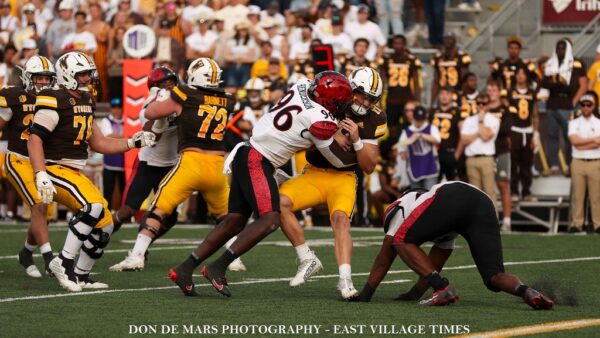
4. Marvelous Mr. Mateer
Saturday, the Aztecs will face potentially the best quarterback they will see all year. Mateer is only a sophomore but ranks fifth in the country in total offense. His 2,429 total yards on the season more than doubles O’Neil’s Aztecs-leading 1,069. Mateer is 16th nationally in passing yards and 45th in rushing yards.
Mateer has only started seven games in his career. His 533 rushing yards have already set a Washington State single-season record for a QB. He has 24 rushes over ten yards and eight over 20 with a long of 68 against Texas Tech.
The sophomore sensation is also no.10 in the nation with 16 touchdown passes. He has a trio of games with over 300 passing yards and one with 295. His season high was 390 passing yards against San Jose State. He also ran for 111 yards in that contest, 86 below his season-high of 197 rushing yards.
Saturday is intriguing because Mateer’s skill sket allows Washington State maximum creativity on its play calling. Washington State uses misdirection as well as anyone in the country. When plays break down, Mateer’s athleticism takes over. It will be interesting to see if the Aztecs use a spy against him because he is a prolific passer, and extra defenders might be needed in the secondary.
Football has become such a copycat game that contrasting styles aren’t as numerous as they used to be. Mateer allows the Cougars to be different.
He has thrown six interceptions this year. SDSU might be wise to put its corners on islands because Mateer underthrows his receivers on deep passes at times.
3. Time of Possession
Every team that SDSU has played has possessed the ball more than their yearly average. The Aztecs’ fast-tempo offense will create this dynamic most seasons. This year, the team’s 3-3 record shows a trend to watch against Washington State.
In each defeat, the Aztecs lost the time of possession battle by more than five minutes. In their three wins, that number was reduced. In its pair of 27-24 conference victories, time of possession was nearly even.
The Cougars can play fast, but their pace is less pronounced than the Aztecs. WSU has won the battle for the clock four times, but only twice by more than four minutes. Their style of play helps the Aztecs compete in a manner that is advantageous to SDSU.
2. Big plays and Sustained Drives
SDSU and WSU share an offensive philosophy. They spread the field to create explosive plays, a single gain of 20 or more yards. Both teams have done well in this area. Washington State has been elite at it.
The Cougars took on Portland State in the season opener. They racked up 637 yards on only 51 plays in a 70-30 victory. In that contest, they had at least seven explosive plays, including receptions of 59, 59, and 52 yards and runs of 54 and 40 yards. Even without these video game numbers against an FCS opponent, WSU has at least 25 huge plays this season.
They generate them because their offense is balanced. When defenses cannot make them one-dimensional, WSU has been hard to stop.
Limiting large gains will be vital for the Aztecs. SDSU has given up 20 big plays this season. With an offense unable to score many points, these gains have proved determinative in the outcome of every contest.
Explosive plays or turnovers have been the catalyst for every SDSU touchdown drive this year. Lewis explained on Monday that the odds of scoring increase by 80% when an offense produces one. As important as these momentum-swingers can be, SDSU has been too dependent on them.
Upsets occur when underdogs accomplish the improbable. The Aztecs will likely need at least one methodical touchdown drive to win on Saturday. Their offense is not generating enough points to rely solely on explosive plays.
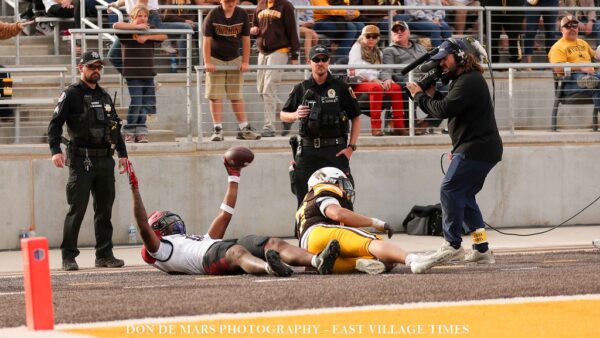
1. Jordan Napier Show
Having witnessed every game in person this season and walked the fields in warmups, saying that SDSU has been athletically equal to or better than all its opponents is not a stretch. Cal might be the only exception.
Even against the Bears, most of SDSU’s secondary, White, Cooper, Tupou’atu-Johnson, and Jude Wolfe, showed they physically belonged. It was the waves of athletes Berkeley sent out that gave them an advantage.
Arguably, among the skill position players on either side in that game, SDSU wide receiver Jordan Napier flashed the most potential. Cal’s running backs had a field day, but most of their work was running into gaping holes. Defense is the Bears’ strength this year, and Napier made that side of the ball look silly, just as he has every defensive unit he’s faced this season.
Cooper is the Aztecs’ best and most important offensive player, Napier has the highest ceiling. SDSU’s team leader in explosive plays is Cooper with seven, but three of those came against FCS Texas A&M-Commerce. Louis Brown IV is next with six, but a third of those came against TAMCU.
Napier is third on the team with four, including a 29-yard catch and run against the Lions. His pair of huge gains against Wyoming turned the tide of that game. Napier’s 40-yard touchdown run against Cal remains the best play an Aztec has made this year.
The redshirt freshman’s star is beginning to rise with his increased opportunities. Following the last game, the university invited him to speak to the media, and he had a radio interview this week on the Jon and Jim Show.
Lewis said this week that the staff utilizes Catapult GPS to track player movement on the field. Using that data, he noted that the distance Napier travels in a game is at a level where adding too much more might reduce his effectiveness late in the game. Napier is a kickoff and punt returner in addition to his work in the slot.
Whatever his present mileage, getting him the ball is imperative. Napier needs to do his part by reducing his number of drops.
In this contest, Napier’s play might be even more important. Sources told EVT that Brown IV missed a team meeting on Sunday. As a result, Mekhi Shaw will start in his place against Washington State.
My earliest sport’s memory involve tailgating at the Murph, running down the circular exit ramps, and seeing the Padres, Chargers and Aztecs play. As a second generation Aztec, I am passionate about all things SDSU. Other interests include raising my four children, being a great husband and teaching high school.